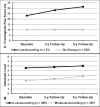Patterns of change in cardiovascular risk assessments and ankle brachial index among Puerto Rican adults
- PMID: 33471871
- PMCID: PMC7817056
- DOI: 10.1371/journal.pone.0245236
Patterns of change in cardiovascular risk assessments and ankle brachial index among Puerto Rican adults
Abstract
Background: Puerto Rican adults have higher odds of peripheral artery disease (PAD) compared with Mexican Americans. Limited studies have examined relationships between clinical risk assessment scores and ABI measures in this population.
Methods: Using 2004-2015 data from the Boston Puerto Rican Health Study (BPRHS) (n = 370-583), cross-sectional, 5-y change, and patterns of change in Framingham Risk Score (FRS) and allostatic load (AL) with ankle brachial index (ABI) at 5-y follow-up were assessed among Puerto Rican adults (45-75 y). FRS and AL were calculated at baseline, 2-y and 5-y follow-up. Multivariable linear regression models were used to examine cross-sectional and 5-y changes in FRS and AL with ABI at 5-y. Latent growth mixture modeling identified trajectories of FRS and AL over 5-y, and multivariable linear regression models were used to test associations between trajectory groups at 5-y.
Results: Greater FRS at 5-y and increases in FRS from baseline were associated with lower ABI at 5-y (β = -0.149, P = 0.010; β = -0.171, P = 0.038, respectively). AL was not associated with ABI in cross-sectional or change analyses. Participants in low-ascending (vs. no change) FRS trajectory, and participants in moderate-ascending (vs. low-ascending) AL trajectory, had lower 5-y ABI (β = -0.025, P = 0.044; β = -0.016, P = 0.023, respectively).
Conclusions: FRS was a better overall predictor of ABI, compared with AL. Puerto Rican adults, an understudied population with higher FRS over 5 years, may benefit from intensive risk factor modification to reduce risk of PAD. Additional research examining relationships between FRS and AL and development of PAD is warranted.
Conflict of interest statement
The authors have declared that no competing interests exist.
Figures
References
-
- United Status Census Bureau. Hispanic or Lation Origin by Specific Origin: 2017 American Community Survey 1-year Estimates. US Cencus Bureau; 2017.
-
- Daviglus ML, Talavera GA, Aviles-Santa ML, Allison M, Cai J, Criqui MH, et al. Prevalence of major cardiovascular risk factors and cardiovascular diseases among Hispanic/Latino individuals of diverse backgrounds in the United States. JAMA. 2012;308(17):1775–84. Epub 2012/11/03. 10.1001/jama.2012.14517 - DOI - PMC - PubMed
-
- McDermott MM, Guralnik JM, Tian L, Liu K, Ferrucci L, Liao Y, et al. Associations of Borderline and Low Normal Ankle-Brachial Index Values With Functional Decline at 5-Year Follow-Up: The WALCS (Walking and Leg Circulation Study). Journal of the American College of Cardiology. 2009;53(12):1056–62. 10.1016/j.jacc.2008.09.063 - DOI - PMC - PubMed
Publication types
MeSH terms
Associated data
Grants and funding
LinkOut - more resources
Full Text Sources
Other Literature Sources



